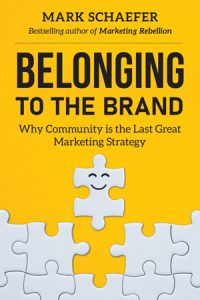 By Stephen Shaw
By Stephen Shaw
“Markets are conversations”.
That was the opening line in the classic marketing book The Cluetrain Manifesto published in the year 2000. The authors urged marketers to give up mass messaging and speak with a human voice. Their clarion call for radical change resonated with many techno-utopian marketers at the time — the book went on to become a huge bestseller — but it was only several years later that the idea of conversational marketing became feasible with the emergence of the social web.
In the early 2000s social networks began springing up everywhere — first MySpace in 2003, followed in rapid succession by Facebook, LinkedIn, YouTube and Twitter, and then a few years later by Pinterest and Instagram. By 2010 marketers recognized the importance of participating on these platforms as they watched their active user bases stretch across the globe. People were flocking to social media in droves, led by millennials keen to connect with their friends, share personal news (and selfies), to voice their thoughts, and of course, marketers are instantly drawn to places where people like to hang out. But instead of engaging in actual conversations, marketers viewed the platforms as just another communication channel — a new, more targeted way to reach an audience, at a fraction of the cost of traditional media.
Talk about unforeseen consequences. The platforms thrived on the sudden surge in ad dollars. And to keep the money rolling in, they skewed their algorithms, as we learned later, to drive engagement by giving undue weight to “us versus them” posts. Indignation and outrage is good for business, apparently. We all know what happened next. The platforms became an echo chamber, giving license to incite hate speech, peddle conspiracy theories, and spread misinformation. Prolonged use began to affect the mental health of teens. To the point where most people now believe that social media does more harm than good.
What we seem to forget, however, is that the mainstream social networks, funded almost entirely by ad dollars, are not all there is to social media. Just as all marketing is now digital marketing, all digital marketing is bound to become social marketing. And that means inviting people to join the brand of their own free will, forming communities of devout fans and followers. Instead of pulling people through the sales funnel by posting thinly disguised promotional messages, the marketing goal is to keep customers excited and involved — to offer them immediate service and support — to put them in touch with each other – to invite continuous feedback — above all, to get them to participate, in events, in content creation, even in product development.
 However, for most companies today, a brand community is merely a way to deflect customer support calls by funneling people through to discussion forums where they can get their questions answered by other users. But where a community actually pays off eventually is in building long-term customer relationships. The challenge is convincing myopic CFOs that all the effort and investment will pay off. Because building an enthusiastic and participatory brand community is not easy. It can take years to reach critical mass. But, as Mark Schaefer points out in his new book Belonging to the Brand, marketers have no choice. He believes that building community is the “last great marketing strategy”. Maybe even marketing’s last gasp.
However, for most companies today, a brand community is merely a way to deflect customer support calls by funneling people through to discussion forums where they can get their questions answered by other users. But where a community actually pays off eventually is in building long-term customer relationships. The challenge is convincing myopic CFOs that all the effort and investment will pay off. Because building an enthusiastic and participatory brand community is not easy. It can take years to reach critical mass. But, as Mark Schaefer points out in his new book Belonging to the Brand, marketers have no choice. He believes that building community is the “last great marketing strategy”. Maybe even marketing’s last gasp.
People “long to belong,” Schaefer says and that presents an opportunity for brands to connect with them on a more meaningful level. The author of nine other books, including the best-selling Marketing Rebellion, the Tennessee resident is well-liked for his humanistic views and folksy charm, making him both a popular speaker and a beloved blogger.
Shaw: Your undergraduate degree was in journalism. How did you end up in marketing?
Schaefer: I loved to write but I always heard you could never make money in journalism. And believe me, I was so poor as a kid, all I ever wanted was to make money. But I loved the people in journalism school — they wanted to change the world. I thought, “This is where I belong.” So, I started out in corporate communications and then I got into sales. And while I was in sales, I got my MBA with an emphasis on marketing and studied under Peter Drucker. So, that was a life-changing event. And then, finally, I got into marketing at a company called Alcoa. I was in product development. I was in charge of CRM. I was the first digital E-business director. We pioneered our first applications in social media. And the company was wonderful. They just pushed me, pushed me, pushed me to realize my full potential. So, I had a great career. And then they wanted me to move to Europe. But I had a personal situation in my life where I needed to try something else. I started consulting, started teaching, and started writing. And it just became a rocket ship.
Shaw: So that early training in journalism paid off after two decades in marketing at Alcoa.
Schaefer: Leaving Alcoa was traumatic, but it was the best decision I ever made. Here I was this global director, accustomed to working with people all over the world, and then the next day it was silent.
Shaw: How long after you quit Alcoa did you land your first consulting assignment?
Schaefer: Here’s how it started. I was on a plane, talking to this guy. He had this massive global jewelry business. He wanted to sell it and couldn’t because he didn’t have a marketing strategy. And I’m sitting there listening, listening, listening. And finally, I said, “I can do this. I can help you.” I’ll never forget that, because it was really my first consulting job, and he paid me in diamonds. And I completely changed his business and the business got sold and he’s a millionaire — multi-millionaire! So, I thought, “I’m good at this.”
I started my business in 2008 and my blog [Grow] in 2009. And then something completely unexpected happened. Instead of me going after my target audience, my audience found me. I thought I could have a very happy life just working for businesses in East Tennessee, but all of a sudden I had a global audience. And a global audience who loved my blog, and the blog led to books and the books led to speaking. Speaking led to bigger and bigger consulting gigs. I’ve worked for Dell and Microsoft and Pfizer and Merck and Chipotle and Allstate and Adidas and all these amazing brands.
Shaw: Had you started your blog maybe five years later, would you have enjoyed the same fast rise to fame that you did?
Schaefer: When I started, there was a marketing leader I admired who told me, “You’re too late and you’re too old.” I was 49, 50 when I started blogging. I gave my first paid speech, I think when I was 52. So, in that context, I was not really a pioneer. But here’s what was different. I told the truth. I was able to use my experience and my age as a benefit, because all the bloggers back then were kids, whereas I could connect the dots. I thought, “They have no idea how business works.” Now, if I had started five years later, it might have taken a little longer to get traction because it was a little more crowded by then, but I do believe that everybody can find their audience.
Shaw: It’s interesting when you say that bloggers at the time were pretty much just kids. I would argue it’s probably still the same today. Look at the bloggers on Medium. Whereas I look at you as the Malcolm Gladwell of marketing.
Schaefer: Oh man, I love that. I love that, I love that. And it’s true because, you know what, I write my books like Malcolm Gladwell.
Shaw: You do.
Schaefer: Here’s the beauty of Malcolm Gladwell. He does no original research. Here’s what Gladwell does, “Sally woke up one morning and couldn’t find her coffee. She…” and there’s this long story and you’re involved in it. And then he goes, “Of course, she couldn’t find her coffee because, in 2011, Stanford University found,” blah-blah-blah-blah-blah.” That’s how I write my books. Thank you for noticing! You’re my new best friend.
Shaw: You are a consummate storyteller! I think the other similarity to Gladwell is that you have a real interest in social psychology. Would you attribute your success to your ability to unpack the complexity of a situation and play it back in a way that people get?
Schaefer: One hundred percent. I’m a teacher. And I remember when my daughter was a little girl and I was helping her with her homework and she said, “Daddy, I’m so confused at school but when you explain it to me, I understand it. You should be a teacher.” And whether it’s my books or my speeches or my classes, I can unpack complicated things. That is what I’m good at. So, you are a very keen observer.
Shaw: I’m a huge admirer of your work, in particular the Marketing Rebellion. There are so many good ideas in that book and lots of stories. The subtitle is The Most Human Company Wins, and that is a theme that runs through all of your writing. You advocate in favour of marketing becoming a more humanistic discipline. Should marketing become the social conscience of the company, despite the pressures of growth on the CMO today?
Schaefer: Why the CMO is such a perilous career path is because there’s this major disconnect between the expectation of the board of directors and customers. The board expects marketing to be coin-operated: you put coins in and you get more coins out. And customers don’t care about that. They care about their life and their problems. And I think the mindset of marketing today needs to be, “How do we be so helpful, so human, so generous, so authentic, so unmissable that customers can’t wait to tell other people about us?” Are businesses going that way? Mostly not. Twenty years from now we’re going to look back at this period in time and say, “What were we thinking? Spam? Robocalls? Oh my gosh, those were awful days.”
Shaw: We’ll be looking back at this time much as we look back at the early years of selling patent medicines.
Schaefer: To go back to your question about the role of marketing, there’s this popular mantra that every brand needs to take a stand. But as consumers we go to a gas station because it’s convenient, we buy a coat because we’re cold, and we buy a house plant because it’s pretty. The four P’s of marketing still work, they’re still important. I think purpose is the fifth P, I really do. And especially with young people today, it is really important. But never overlook the fact that the four P’s still work.
Shaw: This brings me to your latest book, Belonging to the Brand which creates a very convincing case that creating brand communities will, I’m quoting you here, “replace the intrusive marketing systems” of today. Yet we still live in an attention economy. The ad market is a trillion-dollar industry with a vested interest in the status quo. How do you see this rebellion, if I may put it that way, playing out over time?
Schaefer: No one looks at ads anymore. There is a lot of delusion in marketing. I think marketing is sick, in a lot of ways. It’s not changing like it needs to, it’s not changing fast enough. And all I can do is tell the truth and hope that some people listen.
Shaw: I think the phrase you use in “Marketing Rebellion” is “existential crisis”. The challenge I was raising is that it takes a brave CMO to pull the ad syringe out of their arm.
Schaefer: That’s because CMOs love being wined and dined by the agency. Making commercials is sexy. They don’t want to give that up. There’s a whole scaffolding of relationships and ego that’s holding these sick practices in place.
Shaw: It’s self-perpetuating, that’s for sure. CMOs are not going to shed traditional go-to-market methods on a leap of faith. But the other thing you bring up in the book is the impact on society. You point out that 40 percent of people today feel lonely. And 22 percent of millennials have no friends at all. Is social media at the root of all evil here?
Schaefer: That’s a very, very complicated issue. There’s been a steady decline in mental wellness since the 1960s. Increases in divorce rates, more single-parent families, the decline of social institutions like youth sports, and institutions like church and service organizations. We used to belong to all these clubs, but now we spend all our time on our phones. So, it’s a very complicated issue. Social media is this wonderful historic opportunity to meet people and connect in new ways. But it can also be very toxic. It can be a place where there’s bullying and shaming. And I do think, specifically with children today, it’s a big problem. There’s been a lot written about this, I’m not saying anything new. For society in general, there are probably more negatives to social media than positives, at this point.
Shaw: Is it simply a matter of reinventing the concept of social media, decommercializing it? Does the answer lie in creating “digital campfires” — closed communities enabled by platforms like Discord, Mastodon, and Slack? Does it ultimately mean that the big social-media platforms will be displaced by private, invitation-only communities?
Schaefer: I think, in many cases, it already is. This next generation is looking at what’s going on, on Facebook, at Twitter, and they’re saying, “Nope, we’re going someplace else. We’re going to create our own digital campfires where no one can see us.” Social-listening platforms are becoming obsolete because GenZ is hanging out on Discord, they’re hanging out on Fortnite. Young people today are dropping out of mainstream social media.
I’ll give you a quick story, this is heartbreaking. I was working with the brand manager of a Fortune 100 company — we were working on all these creative ideas. And because they had a global universal ad contract, everything she wanted to do had to go through an ad agency and everything came back as an ad. Everything. She couldn’t do anything different. She said, “I’m ready to risk my career by going outside this contract” because she was so boxed in by this scaffolding of sick practices. There’s going to be a big painful wake-up call in the next two years for major brands.
Shaw: You say marketers should be relevant to people’s lives. You use that word in fact quite a bit. Is it important to have a social purpose that the community can rally around?
Schaefer: There is one well-known case study that I present in the book and that’s Harley-Davidson. You never hear Harley-Davidson saying, “It’s our Presidents’ Day sale, come on down now.” You could never imagine them doing that. And they never will because everything in that company — and I have personal experience working at the C level with Harley-Davidson — everything they do is dedicated to one thing: helping people achieve their dreams through the lifestyle of motorcycling. This is a friendly way of saying, “We wanna make you a badass.” So, if you want to be seen as a true badass, you’re never going to see a pink-leather jacket, only a black leather jacket. They have this deep, deep emotional connection with their customers, that’s all they work on. It’s just such a different way of thinking.
Shaw: The difference maker, you seem to be saying, is the brand purpose. But is that possible in a commoditized market?
Schaefer: I have a one-word answer: YETI. It’s an ice cooler. Six or seven years ago, I started noticing people wearing YETI caps and YETI stickers on their cars and their laptop computers. I’m thinking, “Wait a minute, this is an ice cooler. What am I missing here?”. I’ll never forget this moment: I was in Wichita, Kansas, giving a speech, and there were a bunch of students there who wanted to have their picture taken with me. And this young woman got out her phone and the whole back of it said YETI. I just couldn’t believe it. I asked, “Why do you have this?” And she went on for ten minutes telling me about how she loves YETI, she believes in YETI. She told me the whole story. She said, “I don’t have that much money but every Christmas I buy YETI gifts for my family because I believe in YETI.”
Shaw: In the book, you talk about how it was YETI’S head of marketing who was largely responsible for its word-of-mouth popularity, initially by recruiting fishing guides as influencers.
Schaefer: One of the greatest marketing success stories of our generation! It really is. I mean, it was all done through word of mouth. They didn’t have any money to start. They did marketing right because they focused on being meaningful to people.
Shaw: A lot of the ideas in your book are fairly radical and justifiably so because marketing is at the point where it needs bold ideas to survive this existential crisis. If marketing declares ownership of community building, as you propose, and I think it rightfully should, how does it reorganize itself around this idea? How do you now put the community at the heart of marketing thinking and planning?
Schaefer: I think it comes down to this — leadership. It comes down to the culture of the company. If the culture is “always be closing,” the community’s not going to work. And the only individual that can really change the culture of the company is the person at the top who holds the purse strings and is responsible for the strategy. It’s not only got to be mandated, it’s got to be internalized, in performance reviews and objectives and dashboards and measurements. That has to come from the top. That’s the only way it’s going to happen. The culture of the company has to be focused on the community and the customers. I really wish there was a simple answer, but it has to be leadership.
Shaw: Marketing has always been in the business of chasing people where they like to hang out. With a community, you’re asking people to hang out with you. That’s quite a pivot.
Schaefer: This doesn’t have to be a total commitment of the budget. Experiment. Take 10 percent of your budget and try word-of-mouth marketing, and experiential marketing. Some of the things I talked about in Marketing Rebellion. Try those things. Try community. It doesn’t take a lot of money to create a community. It takes commitment, it takes some resources, but, generally speaking, it’s not going to break the bank to build some momentum. It’s not a 180-degree shift. And maybe the first try won’t work. But maybe you can crush your competition because you’re probably not crushing your competition by offering coupons.
Shaw: Toward the end of the book, you state that NFT tokens could be used to reinvent loyalty programs. And certainly, we all know how loyalty programs work today, very transactional – they don’t really inspire an emotional connection to the brand. How do you see tokens fitting into the picture?
Schaefer: I would encourage you to watch what’s happening with Starbucks right now. Starbucks is creating a token-based loyalty program. It’s not the first to do it but it’s the first to do it on this scale. Starbucks is a really smart company, they have a lot of money, a lot of resources. I expect they’re going to do it right. Now, how do you move that into the community? Starbucks used to have one of the largest and most active communities in the world. I think that someone in the community even redesigned their straws. So they have always used their community to co-create. My prediction is that Starbucks will use tokens as a way to somehow enhance the experience.
Shaw: Marketing has splintered into many, many diverse specialties that don’t play well together, if I may put it that way. What we’re facing is spiralling complexity. How do marketers manage this complexity? This lack of cohesion?
Schaefer: A great marketing leader today cannot hope to have all the right answers but they need to have all the right questions. Give up the idea that you’re the master of marketing and you have all the answers. What you need to do is dabble in everything. Experiment in everything. You know, buy an NFT, get out on the metaverse, and play Fortnite. Just learn enough that you know the potential so you can go to your team and ask the right questions. Give up being the smartest person in the room. Have the courage to surround yourself with people a lot smarter than you, probably a lot younger than you.
Shaw: I always like to make the point that a great marketer must have a curious and empathic mind.
Schaefer: Probably the two top skills for marketing today.
Shaw: Last year you gave a TED talk where you spoke about the importance of staying relevant in this era of massive change. And I think you used the metaphor of surfing the next big wave. Is AI going to be the next big wave?
Schaefer: It’s probably the biggest wave, but there are a lot of waves. I think you need to look, just like a surfer, at all the waves coming at you and select one that you think is going to give you the best ride. When ChatGPT came out, I wrote a blog post that said, “This changes marketing forever, beginning now.” I’ve never used those words before in my life. Never. Not even close. This is profound, it really is. It makes artificial intelligence as simple to use as Google. It is going to displace a lot of jobs. It’s going to change everything. All marketing content is going to be AI-generated. But that probably deserves a whole other conversation.
Stephen Shaw is the Chief Strategy Officer of Kenna, a marketing solutions provider specializing in delivering a more unified customer experience. Stephen can be reached via e-mail at sshaw@kenna.ca




